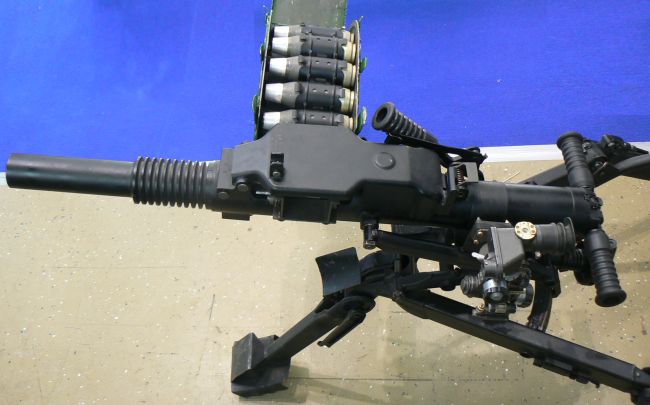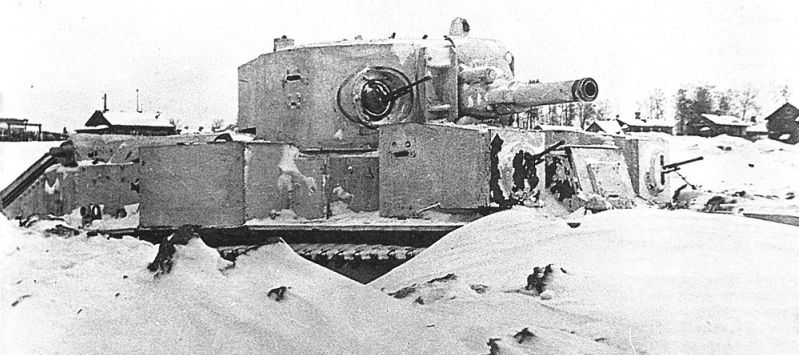[quote="GarryB"]
Ah, but that is the purpose of a MBT, take hits, give hits, move along.
Having a tank face another tank stationary is akin to trench warfare,
something not favorable in a world of maneuvers.
Not all warfare is manoeuvre warfare. The role of the tank is mobile protected fire power, more specifically mobile protected direct fire fire power... as opposed to artillery, which is mobile indirect fire fire power that can often be substituted by air power. Tanks cannot be substituted by air power most of the time. A ground force needs tanks like an air force needs fighters.
Exactly, but a stationary tank is still easier to hit compared to a moving tank, T-64 gun trials showed this.
I meant independent pivot mounts, which are already employed already,
I'm just saying get more of those and get less of coaxials.
You mean like on Israeli tanks with 3 machine gun mounts on top of turrets to suppress infantry?
I am thinking of a proper mini turret that has minimal protection for the gun and its ammo feed back into the vehicle. It gives better elevation and traverse than say a bow mounted weapon as shown on the BMD or BMPT vehicles.
Proper little turrets on the BMPT would be relatively low mounts, and I would give them more clearance by raising the weapons in the turret by using an external 100mm rifled gun from the BMP-3 and a turret bustle autoloader for it to keep the 100mm HE shells out of the crew compartment for safety.
This will mean the front turret mounts should be able to cover the front and sides of the vehicle and with 40mm grenade launchers should be much more powerful than 30 cal weapons.
In many ways I am suggesting the revival of the T-28 with its three turret arrangement where the main turret is the standard placement for turrets today, but with two small turrets in front of it and lower down to give the main turret a clear field of view. The two front MG turrets on the T-28 were huge because they were manned, which meant the main gun in the central turret was up quite high. I am suggesting much smaller unmanned MG turrets fitted with an AGL instead of a MG.
Pretty much. Mini-turrets IMO are quite useless unless you're protecting medium caliber munitions, like 30 mm cannon rounds and 30/40 mm grenades.
Ah, but I'd disagree. A 40 mm grenade is very dangerous, even in
confined conditions.
Any explosive weapon is made more effective in confined conditions... explosive weapons have several ways they can kill and that includes blast and fragmentation... confined conditions make blast more effective.
True, but thermobaric grenades don't offer as much shrapnel than a HE-Frag one, admittedly, the blastwave will pretty much suffocate everyone in the room or even take down the entire room/house. But, in situations like Iraq, it's better to take down one house then to still take down that house but spread shrapnel up and around the same house and throwing shrapnel at other houses.
The situations I'm referring to here are Urban
combat ones, where the tank, and or convoy is ambushed from Insurgents
or regulars that are hiding in civilian buildings 25-100 m away.
This is a rather specific situation to design a tanks features around... the best solution is to not use tanks.
In fact, it is not specific, as it's very common nowadays. IED, roadside bombs, and maybe even roadside Kornet snipers may be still dangerous, but tanks in urban areas are always going to get hit from the sides. Not using a tank is even worst for the crew.
A 40 mm
grenade would cause lots of shrapnel which could penetrate the walls of
the houses thus having another over penetration problem.
The 40mm grenade of the Balkan is actually big enough to enable the use of plastic cased rounds for the HE grenade. (what I mean is that some smaller grenades rely on fragmentation for effectiveness like the 30mm grenade the Russians/Soviets used). This means the blast wave from the grenade will kill you at longer ranges than the plastic bits as fragments will kill
you because the plastic bits are so light they rapidly decelerate and become ineffective.
This means over penetration is not a problem, the only problem is finding the target and getting the grenade on target before they can do what they were planning to do.
A plastic cased HE grenade is basically like a HE bomb. A thermobaric grenade is well, like a thermobaric bomb. The latter has shown to offer more bang for the same weight as the former. Although, as a compromise, I wouldn't be surprised if they made 40 mm thermobaric grenades for the Balkan.
A thermobaric
grenade would just level the house, take whoever's inside, and that'll
be that.
A thermobaric grenade is not a tactical nuke. If you take plastic explosive and look at it by volume about three quarters of it by weight generates huge amounts of O2 and heat, while the remaining one quarter is the fuel that uses that heat and that O2 to burn at highly supersonic speed. A thermobaric round has a small dispersal charge to blow the thermobaric compound into the air around the target and then ignites it using the air around the target. In many ways thermobaric explosive is just fuel... like Petrol (Gasoline). In liquid form it will likely burn, but it needs certain conditions before it will explode. Boil petrol to well beyond its flash point and it wont burn... it will explode, using a small HE charge to vapourise petrol into the air and then have some ignition source to ignite it at just the right time and that explosion will be like a thermobaric blast.
HE detonates faster, but thermobaric material tends to push harder and longer and hotter... and of course it consumes the oxygen in the area around the target too.
What I am trying to say is that a 40mm thermobaric grenade will deal with an average room... to take out the floor of a building you need something like RPO.
I know how they work. :rolleyes:
Admittedly, I did overstate the 43 mm thermobaric grenade's power, but it was used in a metaphorical sense.

Most of the time, the threat isn't where you want it, thus you'd want a maneuverable turret.
Totally agree, that is why I am suggesting the removal of the bow guns on the BMPT and replace them with external guns in mini turrets.
Oh then, that's agreeable.
Until the T-90M is actually produced, that'll change, but for now, the Indians get the better tank.
Why shouldn't they get the better tank... they pretty much kept UVZ alive for the last 20 years. I hope when the T-90M is ready that the Indians will benefit too... though I suspect they wont want a completely new upgrade as that might threaten their own tank design.
It's quite traditional for the manufacturer's country to get the best models.
The photo I have, in fact, does not have any thing that even remotely
reminds me of ARENA, to which btw, a MMW radar basically looks like a
commander's site but without the optics.
What? The MMW radar of ARENA is all those little box antennas fixed on that drum shaped tower on a pole above the turret. The MMW radar antenna on Drodz is circled in green in this image (fitted to a T-55AD which was used to test the system operationally in Afghanistan in the 1980s):
Yes, that's what I was talking about, it basically looks like a commander's site but without the optics (i.e. you don't see glass)
As you know, the T-90M does not have a 1,000 HP engine, it has a 1,250 HP engine.
I know they are working on a 1,250HP engine, but the quote above suggests they are currently using the 1,000hp engine.
This mystery has been solved.
He said more than a few countries buy Russian tanks, and the T-90A got a positive evaluation from testing in difficult climatic conditions, including in Saudi Arabia, India, and Malaysia. In Saudi Arabia, according to Karavayev, the T-90A was the only tank to destroy more than 60 percent of its targets after a road march. Karavayev continues:
“The tests conducted in Saudi Arabia as part of an open tender fully and completely contradict the Glavkom’s [Postnikov’s] assertions.”
This T-90 modification supposedly has a new turret, a 1,000-hp engine, an improved thermal sight, new active defense measures, and a number of other improvements. Karavayev flatly said neither the German Leopard, French LeClerc, nor American Abrams is equal to the T-90.
I believe when they said, "This T-90 modification", they were referring to the T-90A, which was discussed prior. Backchecking, the T-90A does in fact have a 1,000 HP engine, and a new turret (welded).
As you also know, Shtora-2 is fitted for the T-90M. And finally, as you
know, Shtora is an APS system, although soft-kill. It's far more
reasonable to believe that the APS in mention is Shtora-2 than ARENA.
I haven't seen Shtora-2. If they have upgraded Shtora, then why wouldn't they upgrade ARENA as well? The two systems compliment each other.
That's probably because Shtora-2's on the ever elusive T-90M. If they did upgrade ARENA, you or I should of at least heard of some new designation for it, I haven't, have you?
Admittedly Russia cannot afford the diamond molded behemoths we roll out, so why would they increase the cost with ARENA?
Because by far the most common threat for tanks in the world currently is not Javelin or Spike... it is simple dumb RPG rockets flying at sonic speeds rather than hypersonic speeds, and even the old fully developed ARENA deals with those sorts of threats just fine. In the near future or perhaps as we speak its performance can be enhanced to increase the range of targets it can defeat and these features can be added when the vehicles get upgrades.
In that regards, the T-90 is fully protected from the PG-7V from the Front and Sides. The rear is different, but as of now, no tank has all around, including ass protection.
Why not? Profits first!
Because the sales figures will drop when the users find during training that the weapons they spent a fortune on don't go bang because they are empty.
Being as costly as $100,000 per missile, they won't use it for live fire training, they'll buy simulators from us.







